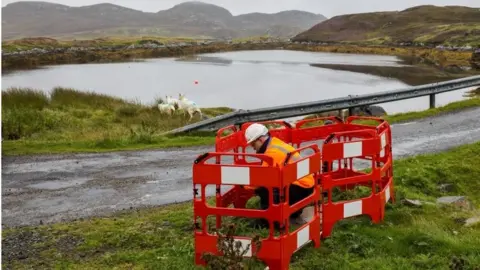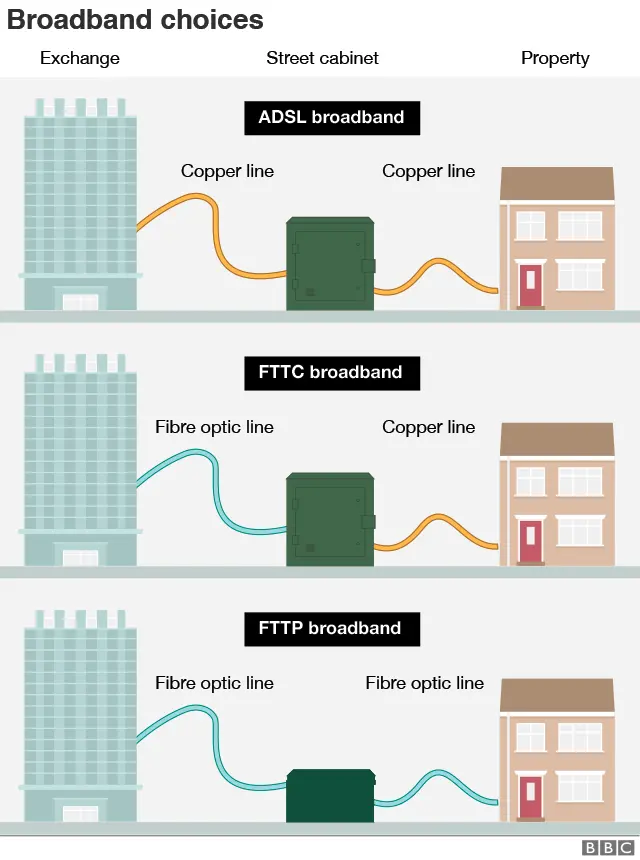UK's full-fibre broadband coverage rises to 8%, says Ofcom
 PA Media
PA MediaAbout 400,000 UK properties gained access to full-fibre broadband for the first time over the first four months of the year, according to Ofcom.
That gave access to a total of 8% of all premises, marking a one percentage point gain, the watchdog said.
The numbers highlight the amount of work that needs to be done if the Prime Minister's goal of providing access "for all" by 2025 is to be achieved.
Ofcom noted that other technologies could also deliver Gigabit speeds.
The advantage of full fibre is that it has the potential to offer much faster speeds than other alternatives in the future.
Boris Johnson had previously said that Theresa May's governments' target of providing full-fibre to the whole country by 2033 was "laughably unambitious".
But the news site ISPreview reported last week that the Department for Digital, Culture, Media & Sport (DCMS) was expected to "water down" Mr Johnson's pledge. It said ministers were likely to only promise "gigafast" speeds by the end of the six-year deadline, regardless of the technology involved.
"This government wants to deliver world-class, gigabit-capable digital infrastructure across the country and will announce further details on how we will achieve this as soon as possible," a spokesman for DCMS told the BBC.
The UK's telecoms industry has previously said it could deliver full-fibre to everyone by 2025, but would require ministers to urgently address several issues, including a reform of property planning laws.
Ofcom notes that Virgin Media's latest copper-based cable transmission technology and 5G wireless networks could "deliver services comparable with full fibre".
"This could potentially provide people with a similar experience to the speeds currently being delivered by full fibre," the report notes.
But one expert noted that whatever the outcome, there would be issues.
"[Deployment of] fibre will need to grow at a faster rate if it is to reach the 100% target in the next six years," said Fiona Vanier from the consultants CCS Insight.
"Schemes such as Virgin Media's Project Lightning are encountering problems with making their targets as well.
"And while 5G can be used for Fixed Wireless Access, coverage is limited and as such it will not be able to compete with full-fibre in the short or medium term."

What is a full-fibre connection?
To understand the advantages of full fibre, it is worth knowing that there are three main types of broadband connections.

ADSL (asymmetric digital subscriber line) involves a situation where both the link between the telephone exchange and the street cabinet, and the onward connection to the property are achieved via copper phone cables.
Fibre to the Cabinet (FTTC) achieves higher speeds by giving the roadside cabinet its own fibre link.
And Fibre to the Premises (FTTP) addresses the final part of the connection - which is often referred to as the "last mile". Under this system, properties can be directly connected to the exchange without passing through a street cabinet, But intermediary boxes - often hidden from view - where fibre links are "split" to serve individual buildings may still be used.
Fibre transmits more bits of data per second by sending pulses of light along optical cables made of glass or plastic. While FTTC offers users average speeds of around 66 megabits per second, FTTP can offer average speeds of one gigabit per second today and potentially terabits per second in the future.

Other results in Ofcom's Connected Nations Update include:
- 2% of properties still do not have access to download speeds of least 10 megabits per second, which has been the case since September 2018
- 95% can get 30Mbit/s "superfast" downloads, the same as four months ago
- 54% can get "ultrafast" speeds of more than 300Mbit/s, a 1% increase on the previous period
- 9% of the UK landmass lacks "good" 4G coverage, which has been the case since September 2018
The regulator noted that it expects the proportion of premises with access to superfast speeds to grow once Scotland's Reaching 100% (R100) broadband initiative begins. The Scottish Government has said it expects to award its first contracts to fibre broadband infrastructure providers by the end of 2019.
In addition, it highlighted that from March 2020 DCMS's universal service obligation will come into force. That means that anyone in the UK who still does not have access to download speeds of at least 10Mbit/s and uploads of at least 1Mbit/s can demand that either BT or KCOM Group - which serves customers in Hull and East Yorkshire - provide such a service.
